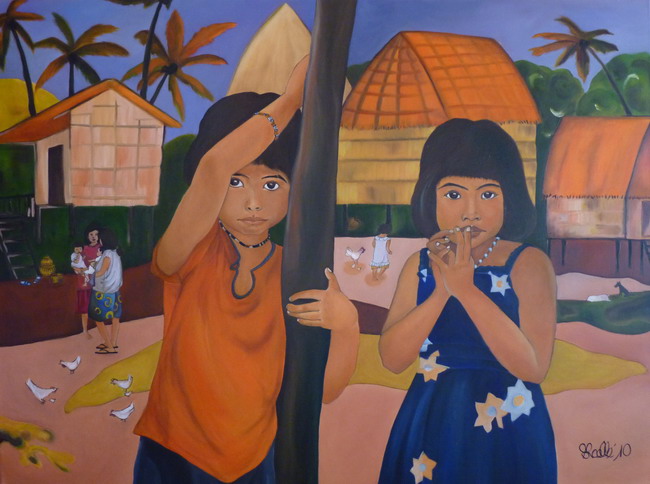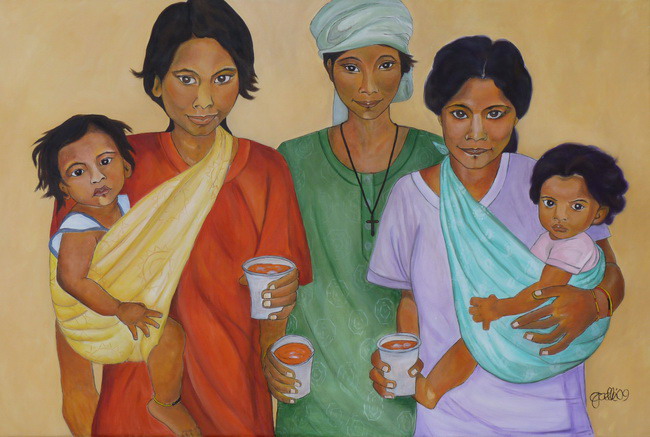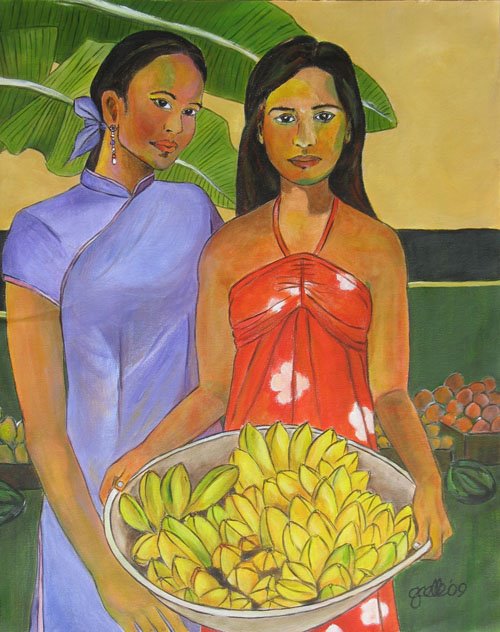
Paintings
| |
| Made in Philippines (2009-2010) |
| Made in Hong Kong (2007-2008) |
| Made in France (2005-2006) |
|
| My Atelier in Philippines (2009-2010) |
Made in Philippines from 2009 (bottom) to 2010 (top) |
After more than a decade of not living in my country of origin, I am glad to now be able to spend more time in the Philippines. As I partly and slowly settles in Mindoro, it is then that I 'discover' the amazing tribal Mangyans who I find most mysterious with their nomad, gentle existence. In effect, most of my paintings made in Phils. will seem to be of that of the Mangyans', as I commemorate them in my canvases in trying to capture as much of my impressions of them.
The Mangyans are historically, the original inhabitants of Mindoro. It is believed that they settled along the shores of Mindoro island approximately 600-700 years ago, coming from the southern regions of the archipelago. They are well-known to be traditionally unwarlike people, choosing to give up an area unconstested rather than fight for it. During the wars brought by the several colonizations of the Phils, the Mangyans would flee into the deepest interiors of the mountain and only come out when the aggresors are gone. Hence, they were able to preserve as much of their tribal culture until the present time.

"Ang Mamamg Sorbetero" (The Local Ice Cream Vendor)
Oil on Canvas, 90 x 90 cm
Thinking that this used to be a traditional thing of the past, I did this painting based from my childhood Summer vacation souvenir in Manila. Yet what a surprise to see that this tradition still lives on.
Sorbetes is a Filipino version of ice cream, made from coconut milk. It is usually peddled by a Sorbetero (the local vendor) using colourful painted wooded cart which can accommodate 3 flavours, each in a large metal canister. The Sorbetero get his cart in the morning and walk the streets the whole day, calling consumers from their houses by ringing a small handheld bell. When I was a kid, I used to prefer mixing all flavours usually served with small wafer or sugar cones. It became a tradition of refreshing from the Summer heat then.
Painting "Ang Mamamg Sorbetero" took me quite a long while to finally finish. I started working on it while I was in Hong Kong~ have been revised several times, put aside and buried low amongst my piles. Once it was in Mindoro, I am delighted that I was able to restrained myself into finishing it before starting another new painting project... done, I am released...

"The Mangyan Girls in Their Village"
Oil on Canvas, 140 x 95 cm
In the island of Mindoro, there are eight (8) indigenous groups of Mangyan, each with its own tribal name, language, and customs. For the record, the total population may be around 100,000, but no official statistics are available because of the difficulties of counting remote and reclusive tribal groups, many of which have no contact with the outside world.
Inspired by these two photos (1 & 2) I took during a trip to a Mangyan village nearby.

"White Lady Orchid"
Oil on Canvas, 50 x 40cm in 4 parts
Experimental painting on the concept of a woman's form.

"The Lowland Mangyan Party"
Acrylic on Canvas, 140 x 95 cm
These ladies are the family of Mang Limon, a lowland Mangyan who works part-time with us in Mindoro. Mang Limon is the head of his household, and the lady in the center is his gentle wife, while the ladies (R & L) are his two timid daughters-in-law w/ their respective kids. Typically, Mangyan mothers practicall carry their kids in this way.

"Le Pepe Provencal"
Acrylic on Canvas Paper, 65 x 65cm
A naive composition, painted as a souvenir of the cliche of old France.

"Mother & Child of Mindoro"
Acrylic on Canvas Paper, 50cmH x 40cmW

"Au Marche (In the Market)"
Acrylic on Canvas Paper, 50cmH x 40cmW

"What Are You Thinking" - The Mangyan Girls
Acrylic on Canvas Paper, 50cmH x 40cmW
The Mangyans are typical tribal group of the island of Mindoro. Very timid and with a gaze difficult to fathom, the Mangyans are very interesting subjects to paint. The girls would typically dress up in loose skirt and t-shirt apparels- either bigger, or smaller sizes than their body size and would typically wear either of the the above footwears. The basket you see above is one example of their beautiful weaved handiworks.

Acrylic on Canvas Paper, 50cmH x 40cmW
Modifying the children's faces, this is an imitation painting I did based on "Piti Teina" (Two Sisters) painting of my favourite French painter Paul Gauguin which he created in 1892. As I was in transition of moving in the Philippines, I felt that it would be symbolic that my first painting made in the Philippines should be of a Gauguin's, whose wonderful artworks ceaselessly give me inspirations to paint for more.
